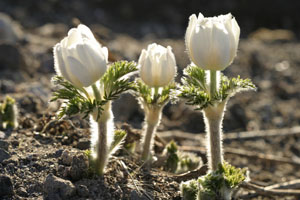Flowering Herbs of Crater Lake National Park
During the long winter, the slopes of old Mount Mazama [Ed: Crater Lake National Park] are covered by a white blanket of snow. Except for the trees, evidence of life is absent; yet beneath the snow lie dormant the seeds, the roots and the runners of a host of plants, quietly resting.
Western Windflowers AnemonesBefore the hills are confident with flowers, Columbine, paint-brush, phlox – the bee’s delight— Come these as silent as the silent hours, Bridesmaids of Spring that fill her path with light. — Ernest G. Moll, former Ranger-Naturalist Western Anemones/Pasque flowers, Crater Lake National Park. Photo by Robert Mutch |
Gradually the days lengthen, the snows cease and summer comes. The woods and meadows stir and begin to rouse from their dormancy. By June melting snow fills the creeks and gullies to the brim. At lower elevations the bare, brown ground begins to appear, at first only as small spots, but rapidly enlarging and merging one with another. Hardly has the snow left the ground, when small shoots, some red, some brown, some green, push their way through the soil. A few are impatient and grown through the thinning snow, spreading, their pale green leaves about it. Rapidly, leaves are produced, carpeting the bare ground in brilliant greens. Shrubs, whose bare but living branches have been buried under the snow, are set free and they, too, burst into green. These stages can be readily seen on any meadow during early summer. The white patches of snow are bordered by bare, brown, sterile-appearing soil, which in turn blends into brilliant green. Suddenly, in a matter of days, the green of woodland and meadow is flecked with colors, purples, pure white, bright yellow, blues, brilliant reds.
As the season advances, the retreating snows are followed up the slopes of the mountains by wide expanses of flowering plants. This riot of color lasts but a short while, then is gone. The porous soil dries, the green turns red and brown, seeds are shed. The year’s growing season is over; soon the snows will come and again all will be white and silent….[Ways Of Mazama Wildflowers – Edwin Braun, Vol. 14, September 1948]
Crater Lake National Park Plant List in PDF form
Vascular Plants Species_Checklist
Other pages in this section


